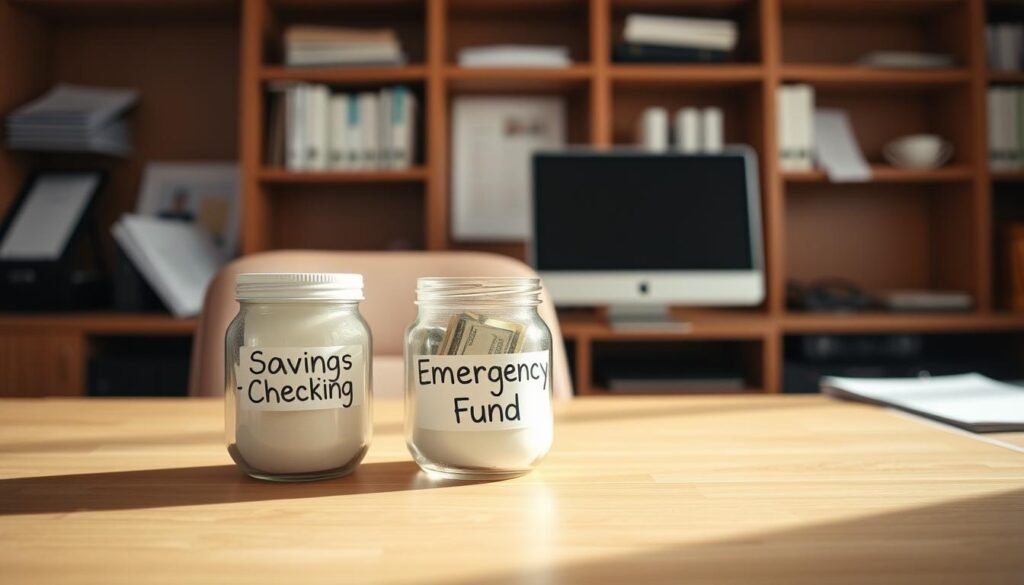Life can surprise us with unexpected events. I learned this the hard way when my car broke down suddenly. It left me in a rush to find money and feeling stressed. This experience showed me how vital it is to budget for emergencies and have a strong financial safety net.
Managing unexpected expenses is more than just a financial plan. It’s your defense against financial worries. An emergency fund is like a shield, keeping you safe from financial storms. It gives you peace of mind when things get uncertain. Whether it’s a medical bill, losing your job, or a big home repair, having money set aside can turn a crisis into a manageable problem.
Preparing for the unexpected doesn’t mean you’re negative. It shows you’re wise, responsible, and care about your financial future. By understanding the value of an emergency fund, you can face life’s surprises with confidence and strength.
Key Takeaways
- Emergency funds protect you from unexpected financial shocks
- Budgeting for emergencies reduces financial stress and anxiety
- A solid financial safety net prevents falling into debt
- Start small and consistently build your emergency savings
- Regular review and adjustment of your emergency fund is crucial
Understanding Emergency Funds: Your Financial Safety Net
Financial emergencies can happen when you least expect them. It’s key to plan for an emergency fund to protect yourself. Without one, even a small financial issue could upset your stability.
A good emergency fund is like a shield against financial disasters. It starts with knowing what counts as an emergency and how to get ready for surprises.
What Qualifies as a Financial Emergency
Not every unexpected cost is an emergency. Real emergencies usually include:
- Unexpected medical expenses
- Critical home or car repairs
- Sudden job loss or income drop
- Emergency vet care
- Urgent travel for family emergencies
The Role of Emergency Savings in Financial Security
Your emergency fund is a key buffer against financial stress. It stops you from getting into high-interest debt when unexpected costs come up. Experts say to save 3-6 months of living costs for a strong safety net.
Common Types of Unexpected Expenses
Knowing about possible financial risks helps in planning your emergency fund. Common surprises include:
- Major appliance replacements
- Medical treatments not covered by insurance
- Emergency home maintenance
- Unexpected tax bills
- Urgent travel expenses
By getting ready for these, you can turn financial uncertainty into a challenge you can handle. This keeps your financial health safe.
Setting Your Emergency Fund Target Amount
Building emergency reserves is not a one-size-fits-all solution. Your emergency cash cushion should match your unique financial situation. Experts suggest saving 3-6 months of living expenses, but this is just a guideline.
When figuring out your emergency fund target, consider these important factors:
- Your current monthly living expenses
- Job stability and income predictability
- Family size and dependents
- Healthcare costs and potential medical emergencies
- Industry volatility and employment risks
First, add up your essential monthly costs. Rent/mortgage, utilities, groceries, transportation, and insurance are key. Then, multiply this by 3-6 to find a good savings goal.
Freelancers and self-employed people might need a bigger emergency fund—6-9 months of expenses. This is because their income can change a lot. On the other hand, people in stable jobs might aim for the usual 3-6 months.
Building emergency reserves takes time. Start with small, reachable goals and grow your savings slowly. The most important thing is to stay consistent and committed to your financial safety.
Getting Started: Building Your First $1,000 Safety Buffer
Starting to budget for emergencies is simple. The goal is to create a $1,000 safety net. This fund helps you deal with unexpected costs and brings peace of mind. Building this reserve doesn’t need big changes, just small, steady steps.
Your journey to save for rainy days starts with knowing how small amounts add up. Here are some weekly savings plans:
- $5 weekly = $260 annually
- $10 weekly = $520 annually
- $15 weekly = $780 annually
- $20 weekly = $1,040 annually
Weekly Savings Goals and Milestones
To make a good savings plan, set clear goals. First, find ways to get extra money:
- Reduce streaming subscriptions
- Pack lunch instead of eating out
- Cancel unused gym memberships
- Sell unused items online
Small Steps to Reach Your First Emergency Fund Goal
Change how you save with these tips:
| Strategy | Potential Savings |
|---|---|
| Round-up bank transactions | $50-$100 monthly |
| Weekend side hustle | $100-$300 monthly |
| Reduce utility costs | $30-$75 monthly |
Tracking Your Progress Effectively
Watching your emergency fund grow keeps you motivated. Use budgeting apps or spreadsheets to see your progress. Celebrate your small victories and keep working on your financial safety.
Creating an Automated Savings System
Planning for an emergency fund gets a lot easier with an automated savings system. It takes away the hassle of manually moving money. This way, you can build up your emergency fund without even thinking about it.
Automating your savings is a smart move for managing money in crises. Your bank probably has several ways to make it easy:
- Direct deposit split allocation
- Recurring scheduled transfers
- Percentage-based automatic savings
- Round-up savings programs
To begin building your emergency fund, follow these steps:
- Determine a realistic monthly savings amount
- Choose a dedicated emergency savings account
- Set up automatic transfers on payday
- Start small and gradually increase contributions
Pro tip: Many banks offer mobile apps that make tracking and adjusting automatic savings transfers incredibly simple.
Make your savings automatic to protect your financial future. Your future self will be grateful for a strong safety net that grows easily and consistently.
Budgeting for Emergencies: Essential Strategies
Building a strong financial safety net needs careful planning and smart budgeting for emergencies. Your emergency fund is more than just a place to save money. It’s a key defense against sudden financial problems that could upset your financial balance.
Assessing Your Current Financial Situation
First, take a detailed look at your finances. Planning for emergencies starts with knowing your income, expenses, and how you spend money. Keep track of your monthly money flow to find places to save.
- Calculate your total monthly income
- List all fixed and variable expenses
- Identify discretionary spending areas
- Review recent unexpected expenses
Identifying Areas for Potential Savings
To budget for emergencies well, you need to cut costs smartly. Look for ways to spend less without lowering your standard of living. Even small savings can add up over time.
- Review subscription services
- Negotiate bills and recurring expenses
- Cut unnecessary dining out or entertainment costs
- Consider more affordable alternatives for regular purchases
Creating a Realistic Emergency Fund Timeline
Building a financial safety net takes time and dedication. Set goals that match your income and financial dreams. Start small and build your emergency fund gradually. A realistic plan helps you succeed over the long term and avoids financial exhaustion.
Try to save 3-6 months of living costs, but start with saving $1,000. Saving a little bit each time will help you build a solid emergency fund. This fund will give you peace of mind and financial security.
Smart Ways to Fast-Track Your Emergency Savings

Building emergency reserves can be easy. Smart savers turn unexpected money into a strong emergency fund.
Here are some quick ways to grow your rainy day savings:
- Capture unexpected windfalls like tax refunds
- Sell unused items around your home
- Take on short-term side gigs
- Participate in savings challenges
Micro-saving techniques can change your financial game. Apps that round up purchases can save you money. For example, if you spend $4.50 on coffee, the app might save the extra 50 cents for you.
The 52-week savings challenge is a great idea. Start by saving $1 in week one, $2 in week two, and keep going. By the end of the year, you’ll have saved over $1,300 for emergencies.
Here are some key strategies to boost your emergency savings:
- Automate small, consistent transfers
- Use cashback rewards for savings
- Redirect any work bonuses
- Cut unnecessary subscription services
Keep track of your savings and celebrate your wins. Remember, every dollar saved is a step closer to financial security.
Separating Wants vs. Needs in Emergency Planning
Understanding the difference between needs and wants is key to managing unexpected expenses. Your financial safety net depends on making smart choices during tough times.
Defining True Financial Emergencies
Not every unexpected situation is a true financial emergency. Crisis money management starts with knowing what’s really needed versus what’s just a want. True emergencies include:
- Medical expenses not covered by insurance
- Critical home or vehicle repairs
- Unexpected job loss
- Essential living expense shortfalls
Creating Clear Spending Guidelines
Protect your emergency fund by setting clear spending rules. Here’s a framework for making decisions:
| Emergency Expense | Non-Emergency Expense |
|---|---|
| Urgent medical treatment | Vacation or entertainment |
| Critical home repair | New electronics or clothing |
| Essential living costs during job loss | Dining out or subscription services |
When facing expenses, ask: Is this essential for my survival and financial stability? Staying disciplined and following clear guidelines helps keep your financial safety net strong for real emergencies.
Managing and Growing Your Emergency Fund
Managing your emergency fund is an ongoing task. It’s not just about setting it up once. It’s a financial tool that needs regular checks and updates.
Building a strong emergency fund involves several important steps:
- Do financial check-ups every quarter
- Update your savings goals when your life changes
- Keep an eye on inflation and adjust your savings
- Look into low-risk investment options
Your emergency fund should be flexible. Life changes fast, and so should your financial safety net. Think about these times when you might need to adjust your emergency fund:
- Changes in your job
- Getting married or divorced
- Having a child
- Big changes in your income
When managing your emergency fund, focus on keeping it easy to access and growing slowly. High-yield savings accounts or short-term CDs can offer better returns while still being liquid.
Regular checks make your emergency fund more than just savings. It becomes a powerful financial safety net. Stay on top of it, stay disciplined, and your emergency fund will keep you financially secure.
Where to Keep Your Emergency Savings
Your emergency cash cushion needs a safe and easy-to-reach spot. Choosing the right place for your money is key. It’s about picking a spot that keeps your savings safe and ready when you need it.

When picking a spot for your emergency fund, think about a few things. You want it to be easy to get to when money problems pop up. But, it should also grow a bit over time.
Comparing Savings Account Options
There are many places to keep your emergency fund. Here are some top choices:
- High-yield savings accounts
- Money market accounts
- Traditional bank savings accounts
- Online savings platforms
Accessibility vs. Growth Potential
| Account Type | Accessibility | Interest Rate | FDIC Insurance |
|---|---|---|---|
| Traditional Savings | High | Low (0.01-0.10%) | Yes |
| High-Yield Savings | Medium | High (3-5%) | Yes |
| Money Market | Medium | Moderate (2-4%) | Yes |
Your emergency fund’s main job is to keep your money safe. Pick an account that’s easy to get to and earns a little interest to beat inflation.
Think about using two accounts for your emergency savings. Keep some in a checking account for quick access. Put the rest in a high-yield savings account for better returns. This way, you get the best of both worlds for your financial safety net.
Protecting and Maintaining Your Emergency Fund
Keeping your financial safety net safe needs careful planning and discipline. Saving money for emergencies is more than just saving. It’s about building a strong defense against unexpected costs that could upset your financial balance.
Here are some important ways to protect your emergency fund:
- Create strict guidelines for what counts as a real financial emergency
- Set clear rules for when you can take money out
- Avoid using the fund for things you don’t really need
- Check and update your emergency savings regularly
Your emergency fund needs constant care. Having the right mindset is as important as being financially disciplined. See this fund as a vital financial safety net, not just another bank account.
| Emergency Fund Protection Strategy | Key Actions |
|---|---|
| Accessibility Control | Keep funds in a separate account with limited immediate access |
| Periodic Review | Reassess fund amount every 6-12 months |
| Replenishment Plan | Immediately start rebuilding after fund withdrawal |
Remember, your emergency fund is a flexible financial tool. As your income changes or life situations shift, so should your approach to handling unexpected expenses. Stay active, disciplined, and dedicated to keeping this essential financial cushion.
Strategies for Replenishing Your Emergency Fund
Rebuilding your rainy day savings after a financial crisis can be tough. But it’s key to managing money in a crisis. When your emergency fund is gone, making a smart plan to get it back is vital for your money health.
Start by figuring out why and how you used your emergency savings. This helps avoid similar money problems in the future.
Creating a Rapid Replenishment Strategy
Here are some good ways to quickly build up your emergency fund:
- Reduce spending on things you don’t need
- Use unexpected money like tax refunds or bonuses
- Make extra cash with a side job
- Cancel subscription services you don’t use
Practical Recovery Techniques
Try these smart ways to grow your savings faster:
- Choose a monthly savings goal
- Make automatic, small savings contributions
- Make quick cash by selling things you don’t need
- Try to get better deals on bills
Remember, rebuilding your emergency fund is a marathon, not a sprint. Consistency and patience are key to financial resilience.
If you used credit cards or loans during your financial emergency, focus on paying off high-interest debt. At the same time, work on rebuilding your savings. This way, you’re looking out for your financial future without adding more stress.
Conclusion
Budgeting for emergencies is more than just a financial plan. It’s your personal safety net. When unexpected costs come up, your emergency fund helps keep your finances stable.
Building an emergency fund takes effort and dedication. You’ve learned how to create a strong plan. This plan helps you face unexpected expenses with confidence.
Your emergency savings journey doesn’t end. The financial world changes, and surprises can happen fast. Keep checking and updating your plan to stay ready for anything.
Start small and stay consistent with your savings. Your emergency fund will grow, making you more financially secure. This isn’t just about now; it’s about your future too.


1 thought on “Budgeting for Emergencies: Planning for the Unexpected”
Comments are closed.